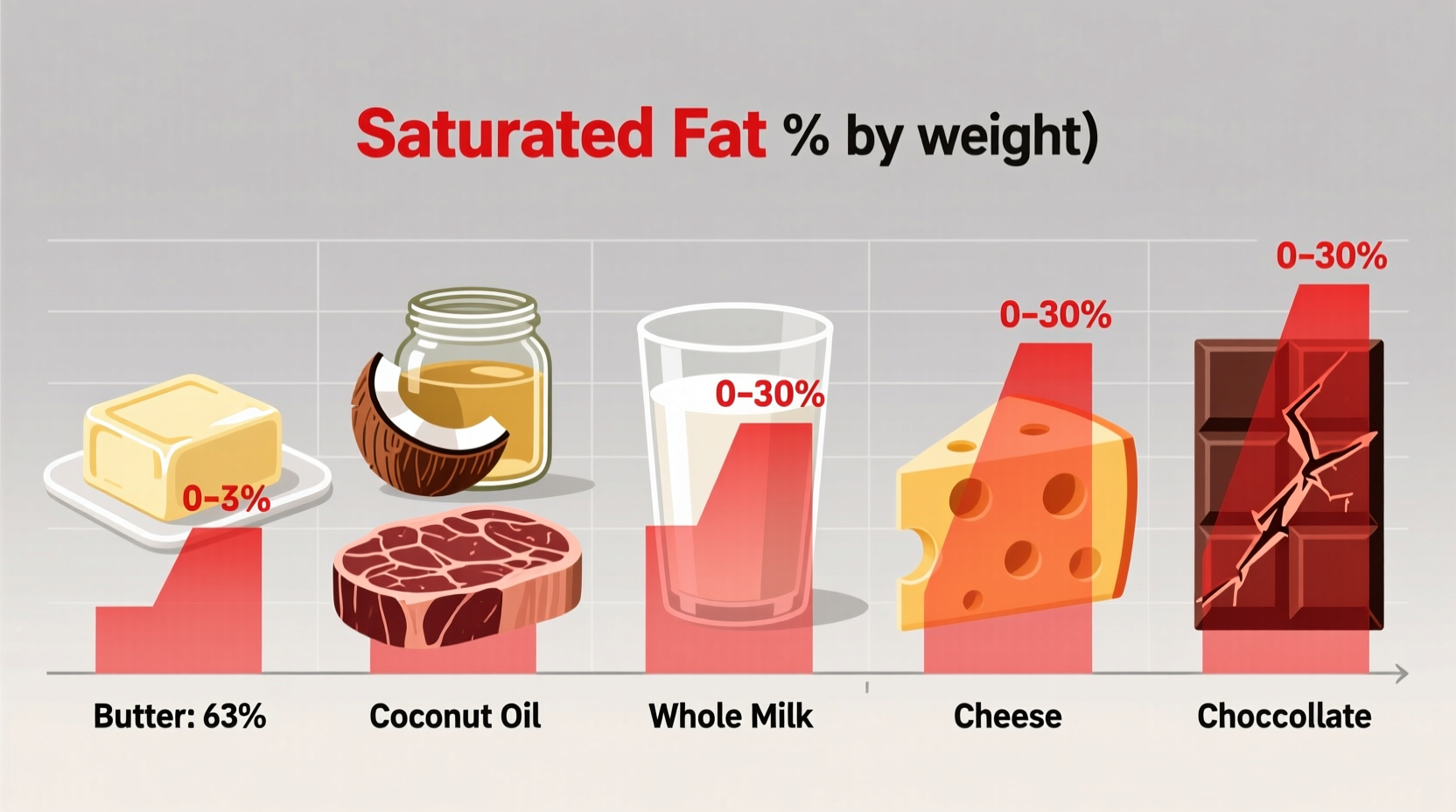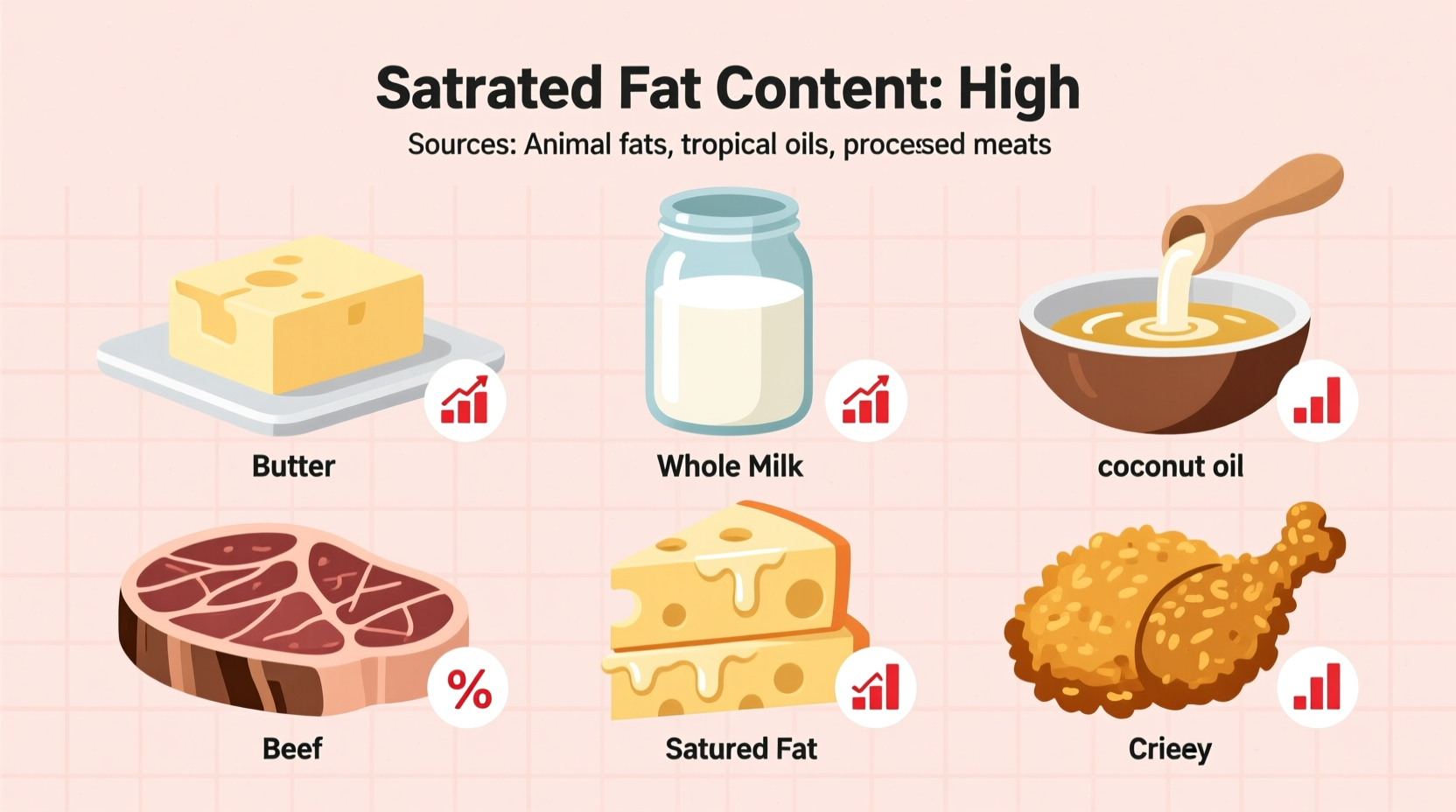Understanding which foods contain saturated fat helps you make informed dietary choices without unnecessary restrictions. This guide provides clear, science-backed information about common foods with saturated fat, their nutritional context, and practical ways to balance your fat intake for better health.
What Exactly Is Saturated Fat?
Saturated fat refers to fat molecules containing no double bonds between carbon atoms. Unlike unsaturated fats (found in nuts, seeds, and fish), saturated fats remain solid at room temperature. While your body needs some dietary fat for essential functions, health organizations consistently recommend limiting saturated fat intake.
The Dietary Guidelines for Americans 2020-2025 advise keeping saturated fat to less than 10% of daily calories. For a 2,000-calorie diet, this means no more than 22 grams of saturated fat per day. The American Heart Association suggests an even stricter limit of 5-6% for those needing to manage cholesterol levels.
Top Food Categories Containing Saturated Fat
Knowing which food categories typically contain higher saturated fat levels helps you navigate grocery stores and restaurants more effectively. These categories represent the primary sources of saturated fat in most Western diets.
Animal-Based Products
Meat and dairy products constitute the largest source of saturated fat for most people. The fat content varies significantly based on animal diet, cut of meat, and processing methods.
| Food Item (100g) | Total Fat (g) | Saturated Fat (g) | % Daily Value* |
|---|---|---|---|
| Butter | 81 | 51 | 255% |
| Cheddar Cheese | 33 | 21 | 105% |
| Fatty Beef (80% lean) | 22 | 9 | 45% |
| Whole Milk | 3.6 | 2.4 | 12% |
| Egg Yolk | 27 | 9 | 45% |
*Based on 20g saturated fat daily limit. Source: USDA FoodData Central
Processed and Packaged Foods
Many convenience foods contain surprisingly high saturated fat levels due to added fats for texture and shelf stability. Food manufacturers often use palm oil and hydrogenated oils in packaged goods. Always check ingredient lists for "partially hydrogenated oils" which indicate trans fats, even if labeled "0g trans fat" (allowed under 0.5g per serving).
Baked Goods and Desserts
Cakes, cookies, pastries, and pie crusts frequently contain butter, shortening, or palm oil. A single commercial croissant can contain 8-10g of saturated fat. Restaurant-prepared desserts often have even higher amounts due to generous use of butter and cream.
Understanding Saturated Fat in Context
Dietary recommendations regarding saturated fat have evolved significantly over time. In the 1980s, all fats were considered problematic. Today's nutrition science recognizes that not all saturated fats behave the same way in the body, and food context matters significantly.
Dietary Fat Recommendations Timeline
- 1970s-1980s: All fats viewed negatively; low-fat diets heavily promoted
- 1990s: Distinction made between saturated and unsaturated fats
- 2000s: Trans fats identified as particularly harmful; saturated fats still limited
- 2010s: Research shows complex relationship between saturated fats and heart disease
- 2020s: Focus shifted to overall dietary patterns rather than single nutrients
Current understanding emphasizes that the health impact of saturated fat depends on what replaces it in the diet. Replacing saturated fats with refined carbohydrates shows little benefit, while replacing them with unsaturated fats demonstrates clear cardiovascular advantages.
Making Practical Dietary Adjustments
You don't need to eliminate all saturated fat-containing foods. Instead, focus on these practical strategies:
- Choose leaner protein options: Select poultry without skin, fish, and lean cuts of meat (look for "loin" or "round")
- Modify dairy consumption: Switch to low-fat or fat-free dairy products where appropriate
- Read nutrition labels: Compare products and choose options with lower saturated fat percentages
- Cook smarter: Use liquid oils like olive or canola oil instead of butter for cooking
- Portion control: Enjoy high-saturated-fat foods in moderation rather than elimination

When Saturated Fat Fits in a Healthy Diet
Certain situations make saturated fat consumption more appropriate. Athletes with high caloric needs may benefit from the dense energy provided by fats. Older adults struggling to maintain weight might find full-fat dairy helpful. Some traditional diets like the Mediterranean pattern include moderate saturated fat from cheese and yogurt alongside abundant fruits, vegetables, and healthy fats.
The key is understanding that saturated fat isn't inherently "bad"—it's about balance within your overall dietary pattern. Complete elimination of all saturated fat sources isn't necessary or practical for most people.
Reading Nutrition Labels for Saturated Fat
When evaluating packaged foods, focus on both the absolute amount and the percentage of daily value. A food with 5g or more saturated fat per serving qualifies as "high" in saturated fat. Be particularly cautious with "low-fat" products that often replace fat with sugar.
Remember that food manufacturers can list "0g trans fat" while still containing up to 0.5g per serving if they use partially hydrogenated oils. Always check the ingredient list for this potentially harmful additive.
Common Misconceptions About Saturated Fat
Several myths persist about saturated fat that can lead to unnecessary dietary restrictions or poor choices:
- Myth: All saturated fat is equally harmful
Fact: Research suggests different saturated fatty acids have varying effects on cholesterol levels - Myth: Coconut oil is a "healthy" saturated fat
Fact: Coconut oil is 90% saturated fat and raises LDL cholesterol similar to butter - Myth: Saturated fat causes heart disease directly
Fact: The relationship is complex and influenced by overall diet quality and lifestyle factors
For accurate information, rely on major health organizations like the American Heart Association rather than popular diet trends.
Building a Balanced Approach to Dietary Fats
Instead of focusing exclusively on saturated fat, consider your overall fat profile:
- Include sources of monounsaturated fats (olive oil, avocados, nuts)
- Ensure adequate omega-3 fatty acids (fatty fish, flaxseeds, walnuts)
- Limit processed foods containing hydrogenated oils
- Enjoy saturated fat-containing foods in appropriate portions
A Mediterranean-style eating pattern demonstrates how to include moderate saturated fat while emphasizing plant-based foods, healthy fats, and lean proteins. This approach has proven benefits for heart health without requiring obsessive tracking of single nutrients.











 浙公网安备
33010002000092号
浙公网安备
33010002000092号 浙B2-20120091-4
浙B2-20120091-4